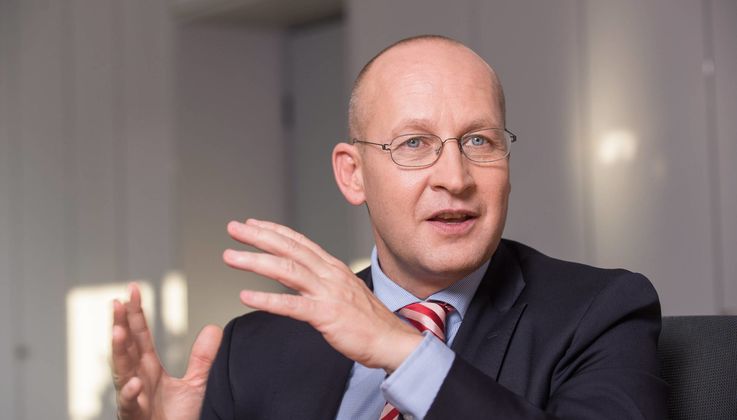
“We need the courage to think long-term!”
Whenever the topic of innovation comes up, conversation inevitably turns to Singapore: in this interview, Evonik Chief Innovation Officer Dr. Ulrich Küsthardt explains what makes the city-state so successful and what Germany could learn from it.
Singapore is a hot spot for research and development in Southeast Asia, especially when it comes to cutting-edge fields. Evonik is taking advantage of that unique environment too, with its Tissue Engineering Project House and its recently opened research center for Resource Efficiency.
What made Evonik decide to establish a research center in Singapore?
Singapore is a city where a number of factors come together: Its many top researchers and talented . The city is also home to research in fields like 3D printing and tissue engineering, which are going to be important going forward and are of interest to us. And finally, Singapore has built an innovation ecosystem that brings universities, startups, and industry together in a very small space. Exactly what you need, in other words, to create a hotbed of innovation.
Do people in Singapore have a sixth sense for the future?
I once heard a nice saying to that effect: “The future isn’t something you enter—it’s something you shape.” The future is essentially taking shape right now. Singapore has managed to bring people together from an extraordinary range of nationalities who are united by their innovative mindset. That diversity is one of the factors in the city’s success.
Does that environment allow companies to make more progress than they can in Germany?
Not as a general rule—it all depends on the field. Thanks to Creavis, Evonik’s strategic innovation unit in Marl, we’ve been demonstrating for 20 years that research in Germany can be highly innovative and successful. But I think it’s extraordinarily important that for us to push ahead with innovations all over the world—we’re an international company, after all. Especially seeing how certain locations are pretty much made for certain fields, the way Singapore is perfect for 3D printing and tissue engineering.

Can Germany learn anything from Singapore?
Absolutely. The diversity there didn’t just appear out of nowhere. The government has made some very smart investments in fields that are important going forward and has built an outstanding landscape surrounding those investments. Government leadership was extremely helpful in their case. Especially since that leadership wasn’t random: it focused on specific trending issues and jump-started the corresponding organizations across the board—from university research and application-specific institutes to startups and companies with global operations. It all comes down to the fact that the government is highly aware that innovation is what will launch the country toward a successful future.
That kind of long-term perspective and big-picture thinking is extremely important. Does it seem to you that we’ve lost some of that in Germany? That we’re investing too little in education, for instance?
Definitely. That’s one of our basic problems. The government of Singapore has its eyes on the long term and is investing a lot of money in areas where you can’t expect results within three to four years—within an election cycle, in other words. In so many cases, the fruit of those investments will be reaped by other people decades later. It takes courage to move ahead in spite of that—and we could certainly use more of that courage here.
Do you see any risk of Germany being left behind as a driver of innovation?
There are already some areas where other countries have taken our place. But Germany still has strengths that we should keep in mind, and we should be bolder in asserting those strengths. However, one basic prerequisite for remaining an innovation driver is education. In my opinion, universities could use a good bit more leadership, so that they can set up thematic centers similar to those in Singapore.
And finally, what do you personally need in order to be innovative?
I try to keep myself young. Children try things out—and if they fall, they get right back up. As you get older, you run the risk of letting your experience dominate your thinking and blind you to new alternatives. That’s why I make a conscious effort to hold on to that child-like perspective.



